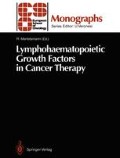Abstract
T lymphocytes develop and mature within the thymus gland [1]. It seems likely that the thy-mus has evolved as a site for the provision of efficient signalling of T-cell maturation. In addition, recent studies have indicated the importance of antigen expression (especially expression of self-MHC antigens) by the thymic environment in shaping the T-cell receptor repertoire by positive selection, i.e., selection of T cells with useful receptors, and negative selection, i.e., removal of potentially autoreactive cells [2].
Access this chapter
Tax calculation will be finalised at checkout
Purchases are for personal use only
Preview
Unable to display preview. Download preview PDF.
References
Miller JFP and Osoba D: Current concepts of immunological function of thymus. Physiol Rev 1967 (47):437–487.
von Boehmer H, Teh HS and Kisielow P: The thymus selects the useful, neglects the useless, and destroys the harmful. Immunol Today 1989 (10):57–61.
Hedrik SM, Cohen DI, Nielson EA and Davies MM: Isolation of cDNA clones encoding T cell specific membrane-associated proteins. Nature 1984 (308):145–148.
Hayday AC, Saito H, Gilles SD, Kranz DM, Tonigawa G, Eisen HN and Tonegawa S: Structure, organization and somatic rearrangement of T cell gamma genes. Cell 1985 (40):259–269.
Bjorkman PJ, Saper MA, Samraour B, Bennet WS, Strominger JL and Wiley DC: The foreign antigen binding site and T cell recognition regions of class I histocompatibility antigens. Nature 1987 (329):506–512.
Kappler J, Roehm N and Marrack P: T cell tolerance by clonal elimination in the thymus. Cell 1987 (49):273–280.
Marrack P, Lo D, Brinster R, Palmiter R, Bunkly L, Flavell RH and Kappler JW: The effect of thymus environment on T cell development and tolerance. Cell 1988 (53):627–634.
Springer TA, Dustin ML, Kishimoto TK, and Marlin SD: The lymphocyte function-associated LFA-1, CD2 and LFA-3 molecules: cell adhesion receptors of the immune system. Ann Rev Immunol 1987 (5):223–252.
Parnes JR: Molecular biology and function of CD4 and CD8. Adv Immunol 1989 (44):265–311.
Shaw S, Luce G, Quinones R, Gress RE, Springer TA and Sanders ME: Two antigen-independent adhesion pathways used by human cytotoxic T cell clones. Nature 1986 (323):262–264.
Alexander DR and Cantrell DA: Kinases and phosphatases in T cell activation. Immunol Today 1989 (10):200–205.
Barber EK, Dasgupta JD, Schlossmann SF, Trevillyau JM and Rudd CE: The CD4 and CD8 antigens are coupled to a protein-tyrosine kinase (p56lck) that phosphorylates the CD3 complex. Proc Natl Acad Sci USA 1989 (86):3277–3281.
Bach F, Widmer M, Segall M, Bach M and Klein J: Genetic and immunological complexity of major histocompatibility regions. Science 1978 (176):1024–1037.
Wagner H and Röllinghoff M: T-T cell interactions during in vitro cytotoxic al log raft responses. I. Soluble products from Lyt1+ cells trigger autonomously antigen-primed Lyt2, 3+ T cells to proliferation and cytolytic activity. J Exp Med 1978 (148):1523–1529.
Mosmann TC and Coffman RL: Heterogeneity of cytokine secretion patterns and function of helper T cells. Adv Immunol 1989 (46):111–147.
Schmidberger R, Miethke T, Heeg K and Wagner H: Primary activation of murine CD8 T cells via crosslinking of T3 cell surface structures: Two signals regulate induction of interleukin 2 responsiveness. Eur J Immunol 1988 (18):277–282.
Widmer MB and Grabstein KH: Regulation of cytolytic T lymphocyte generation by B cell stimulatory factor. Nature 1987 (326):795–798.
Miethke T, Schmidberger R, Heeg K, Gillis S and Wagner H: Interleukin 4 (BSF-1) induces growth in resting murine CD8+ T cells triggered via crosslinking of T3 cell surface structures. Eur J Immunol 1988 (18):767–772.
Bubeck R, Miethke T, Heeg K and Wagner H: Synergy between interleukin 4 and interleukin 2 conveys resistance to cyclosporine A during primary in vitro activation of murine CD8 cytotoxic T cell precursors. Eur J Immunol 1989 (19):625–630.
Heeg K, Gillis S and Wagner H: Interleukin 4 bypasses the immune suppressive effect of cyclosporine A (CsA) during the in vitro induction of murine cytotoxic T lymphocytes. J Immunol 1988 (141):2330–2334.
Singer A, Muritz TE, Golding H, Rosenberg A and Mizuocki T: Recognition requirements for the activation, differentiation and function of T-helper cells specific for class I MHC alloantigens. Immunol Rev 1987 (98):143–170.
Heeg K, Steeg C, Schmitt J and Wagner H: Identification of interleukin 2 producing T helper cells within murine Lyt2+ T lymphocytes: frequency, specificity and clonal segregation from Lyt2+ precursors of cytotoxic T lymphocytes. J Immunol 1987 (138):4121–4127.
Author information
Authors and Affiliations
Editor information
Editors and Affiliations
Rights and permissions
Copyright information
© 1990 Spinger-Verlag Berlin Heidelberg
About this paper
Cite this paper
Wagner, H., Heeg, K. (1990). Mechanisms of T-Cell Activation. In: Mertelsmann, R. (eds) Lymphohaematopoietic Growth Factors in Cancer Therapy. ESO Monographs. Springer, Berlin, Heidelberg. https://doi.org/10.1007/978-3-642-76037-2_3
Download citation
DOI: https://doi.org/10.1007/978-3-642-76037-2_3
Publisher Name: Springer, Berlin, Heidelberg
Print ISBN: 978-3-642-76039-6
Online ISBN: 978-3-642-76037-2
eBook Packages: Springer Book Archive

